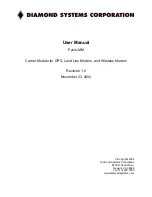
1011-540 5-17-04
Operation
15
S&C Electric Company
BankGuard PLUS
Proprietary Information
Control
value, the appropriate control action is taken. The control will lockout the bank if the
“Gross Over Voltage Level” or the “Lockout Level” setpoint value is exceeded. Or issue
an alarm if the “Alarm Level” setpoint value is exceeded.
Ungrounded Wye Shunt Reactors
The BankGuard PLUS Automatic Control Device provides protection of ungrounded,
wye-connected shunt reactors (Figure 5), either 3-phase reactors or 3-phase banks of
single-phase reactors. The control device detects turn-to-turn faults in the windings of
these shunt reactors, the most common mode of reactor failure. When a developing turn-
to-turn fault occurs in any phase winding, the shunt reactor is protected from further
damage by automatic switching provided by the control device. The control device locks
out the entire shunt reactor when the neutral-to-ground voltage exceeds the calculated
level. (See the Setup Instruction Sheet 1011-530 for more details.) In general, you should
enable the unbalance compensation feature if the magnitude of the calculated error voltage
caused by inherent reactor unbalance resulting from manufacturing-tolerance variations
among the phase windings approaches 50% of the desired lockout-level setting.
For ungrounded, wye-connected shunt reactors, the control device uses an analog input
and digital voltmeter to detect the reactor neutral-to-ground voltage, as monitored by an
S&C 15-Volt-Ampere Potential Device. A digital filter attenuates harmonics and noise.
When the Unbalance Compensation feature is disabled, the magnitude of the real-time
neutral-to-ground voltage is compared with the “Gross Over Voltage Level”, “Lockout
Level”, and “Alarm Level” setpoint values, if enabled. Reactor-turn failures will cause the
real-time neutral-to-ground voltage magnitude to change. If the real-time neutral-to-
ground voltage magnitude exceeds a setpoint value continuously for a time greater than
the applicable time delay setpoint value, the appropriate control action is taken. The
control will lock the reactor out if the “Gross Over Voltage Level” or the “Lockout Level”
setpoint value is exceeded. The control will issue an alarm if the “Alarm Level” setpoint
value is exceeded.
In addition to the neutral-to-ground potential device, one 30-Volt-Ampere S&C Potential
Device is required to be installed on any one of the line phases to obtain a reference angle
when the Unbalance Compensation feature is set to “Reactor” only. During the setup of
the Unbalance Compensation feature, a neutral-to-ground voltage magnitude sample and a
reference angle (Aref) sample are used to obtain and store an approximate magnitude
correction value (see Signal Processing below for an explanation of how the value is
calculated). Setup of the Unbalance Compensation feature should be accomplished during
a time when any voltage unbalances caused by the loads are minimal. During each control
cycle, the stored, approximate magnitude correction value is subtracted from the real-time
neutral-to-ground voltage magnitude to obtain a compensated neutral-to-ground voltage
magnitude. Reactor -turn failures will cause the real-time neutral-to-ground voltage
magnitude to change and, therefore, change the compensated neutral-to-ground voltage
magnitude. The control compares the compensated neutral-to-ground voltage magnitude
with the “Gross Over Voltage Level”, “Lockout Level”, and “Alarm Level setpoint values,
if enabled. If the compensated neutral-to-ground magnitude exceeds a setpoint value














































